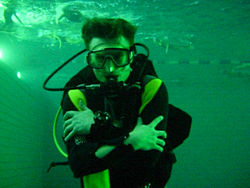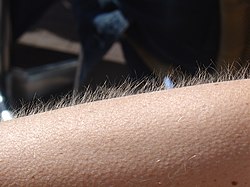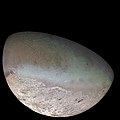Cold
Cold is a relative term used in comparison with the adjective warm (opposite of cold). Because it is relative, there is no range in coldness. The temperatures in the winter season are often categorized as being cold. Cold is the opposite of hot.
The coldest possible temperature is −273.15 °C, which can be expressed as −459.67 °F on the Fahrenheit scale. This is called absolute zero. Absolute zero is also 0 K on the Kelvin scale and 0 °R on the Rankine scale
Cooling
Cooling is when an object gets cold, or lowers in temperature. This can happen by taking away heat, or by putting something in a place with a lower temperature. Fluids used to cool objects are called coolants.
Air cooling is making the temperature of an object lower using air. This will only work if the air is at a lower temperature than the object. The process will work better if there is more surface area on the object or if the item's mass can be made smaller.
Other ways to cool objects include using ice, dry ice, or liquid nitrogen. This works by convection; the heat is taken from the relatively warm object to the relatively cold coolant.
Cold locations and objects
- The Boomerang Nebula is the coldest known place in the universe. Scientists believe the temperature is 1 K (kelvin) (−272.15 °C/−457.87 °F).[1]
- Herschel Space Observatory equipment is kept at temperatures below 2 K, using a large helium tank for cooling.[2]
- Neptune's moon Triton has a surface temperature of −235 °C (−390 °F).
- Uranus has an atmospheric temperature of −215 °C (−355 °F).[3]
- Saturn has a temperature of −175 °C (−285 °F) at cloud tops.[4]
- Mercury, even though it is close to the Sun, is actually cold during the night. It has a temperature of about −170 °C (−275 °F). Mercury is cold at night because it has no atmosphere to trap in heat from the Sun.[5]
- Jupiter has a temperature of −145 °C (−230 °F) at the cloud tops.[6]
- Mars has a temperature of about −125 °C (−195 °F).[7]
- The coldest continent on Earth is Antarctica.[8] The coldest place on Earth is the Antarctic Plateau,[9] an area of Antarctica around the South Pole that has an altitude of around 3000 meters. The lowest measured temperature on Earth, −89.2 °C (−128.6 °F), was recorded at Vostok Station on 21 July 1983.[10]
Cold Media
An iceberg, which is commonly associated with cold
Signal "cold" – unofficial (except recommended by CMAS), it is nonetheless used by many schools of diving and propagated through diving websites as one of the more useful additional signals
Goose bumps, a common physiological response to cold, aiming to reduce the loss of body heat in a cold environment
A photograph of the snow surface at Dome C Station, Antarctica. A part of the notoriously cold Polar Plateau, it is representative of the majority of the continent's surface.
Out In The Cold, Léon Bazille Perrault
Neptune's moon Triton
Cold desert of the Himalayas in Ladakh
References
| Wikimedia Commons has media related to Lua error in Module:Commons_link at line 62: attempt to index field 'wikibase' (a nil value).. |
- ↑ "Boomerang Nebula boasts the coolest spot in the Universe". NASA's Jet Propulsion Laboratory. June 20, 1997. Archived from the original on August 27, 2009. Retrieved July 8, 2009.
- ↑ Jonathan Amos (9 February 2009). "'Silver Sensation' Seeks Cold Cosmos". BBC News. http://news.bbc.co.uk/2/hi/science/nature/7864087.stm. Retrieved 2009-03-06.
- ↑ "NASA - Uranus". Archived from the original on 2010-12-27. Retrieved 2010-05-07.
- ↑ "NASA - saturn". Archived from the original on 2010-12-29. Retrieved 2010-05-07.
- ↑ "NASA - Mercury". Archived from the original on 2005-01-05. Retrieved 2010-05-07.
- ↑ "NASA - Jupiter". Archived from the original on 2005-01-05. Retrieved 2010-05-07.
- ↑ "NASA - Mars". Archived from the original on 2006-10-01. Retrieved 2010-05-07.
- ↑ "Melting Ice in Antarctica". earthobservatory.nasa.gov. 25 September 2007.
- ↑ Bignell, Paul (2007-01-21). "Polar explorers reach coldest place on Earth". The Independent (London). https://www.independent.co.uk/news/science/polar-explorers-reach-coldest-place-on-earth-433074.html. Retrieved 2010-04-30.
- ↑ Budretsky, A.B. (1984). "New absolute minimum of air temperature". Bulletin of the Soviet Antarctic Expedition (in Russian). Leningrad: Gidrometeoizdat (105). Archived from the original on 2009-02-27. Retrieved 2010-05-07.
{{cite journal}}: CS1 maint: unrecognized language (link)









